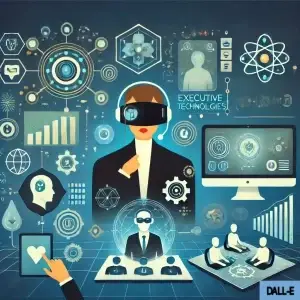No products in the cart.

Harnessing Immersive Technologies in
Executive Coaching

The landscape of executive coaching is evolving rapidly with the integration of immersive technologies. Virtual Reality (VR), Mixed Reality (MR), and Augmented Reality (AR) are transforming the way leaders learn, develop skills, and prepare for complex business scenarios.
These technologies offer a unique opportunity for executives to not just imagine but experience environments and interactions that accelerate learning and integration of crucial leadership components.
The Power of Immersive Experiences in Executive Development
Immersive technologies provide a safe, controlled environment for executives to practice and refine their skills. These experiences go beyond traditional role-playing or case studies by creating realistic, multi-sensory scenarios that engage participants on a deeper level.
Key Benefits of Immersive Technologies in Executive Coaching
1. Enhanced Skill Practice
– Realistic simulations of high-stakes situations
– Immediate feedback and performance analysis
2. Increased Empathy and Perspective-Taking
– Immersive experiences in diverse workplace scenarios
– Virtual embodiment exercises to understand different perspectives
3. Accelerated Learning
– Experiential learning that improves retention and application
– Repeated practice without real-world consequences
4. Global Collaboration and Communication
– Virtual meeting spaces for geographically dispersed teams
– Cross-cultural communication simulations
5. Stress Management and Resilience Building
– Controlled exposure to stressful situations
– Virtual mindfulness and relaxation environments
Implementing Immersive Technologies in Executive Coaching
1. Virtual Leadership Simulations
– Customized scenarios reflecting real business challenges
– Practice decision-making and crisis management in real-time
2. 360-Degree Feedback in VR
– Immersive presentation of feedback data
– Virtual role-reversal exercises
3. Virtual Team Building
– Collaborative problem-solving in virtual environments
– Building trust and communication in remote teams
4. Empathy Training through VR
– Simulations of diverse workplace scenarios
– Experiencing different roles within the organization
5. Stress Resilience Training
– VR-based mindfulness and meditation exercises
– Exposure therapy for public speaking or high-pressure situations
The Science Behind Immersive Learning
Dr. Jeremy Bailenson, in his book “Experience on Demand,” emphasizes the unique power of VR in creating presence – the feeling of actually being in a virtual space. This sense of presence leads to stronger emotional engagement and more effective learning outcomes. Bailenson’s research demonstrates that well-designed VR experiences can lead to behavioral changes that persist in the real world.
Case Example: Soft Skills Gap
Today’s companies face a significant soft skills gap. Virtual reality (VR) emerges as a promising solution, offering immersive, interactive experiences that enhance learning and development. Companies like H&R Block and Cognizant use VR to train employees in customer service and presentation skills, resulting in improved performance and efficiency. After VR training, H&R Block found that “70% of their customer service representatives preferred the new VR program to traditional learning tools, and that the reps consistently reported that the VR simulations helped them improve their skills in handling difficult conversations. The company also saw a 50% decrease in dissatisfied customers, a 9.9% decrease in customer handling times, and significantly faster issue resolution times among the representatives who completed the program.” VR training is not only more engaging but also cost-effective, as evidenced by a PwC study showing employees complete VR programs faster than traditional methods. VR is set to become a key tool for developing essential soft skills.
Challenges and Considerations
While immersive technologies offer significant benefits, their implementation requires careful planning:
1. Technology Investment: Initial costs for VR/AR equipment and software development
2. Content Creation: Developing high-quality, relevant scenarios
3. Integration with Existing Programs: Blending immersive experiences with traditional coaching methods
4. Measuring ROI: Developing metrics to assess the impact of immersive training

Immersive technologies are revolutionizing executive coaching by providing unparalleled experiential learning opportunities. By allowing leaders to practice complex skills in realistic, consequence-free environments, these technologies accelerate learning and development.
As the technology continues to advance, immersive experiences will likely become an integral part of comprehensive executive coaching programs, preparing leaders to navigate the complexities of the modern business world with greater confidence and skill.
Dr. Stone has a specialty in immersive technology. She has written about the benefits extensively and served as a Chief Psychology Officer for a VR company.
Contact Dr. Stone for a whole-person coaching chemistry call today!

